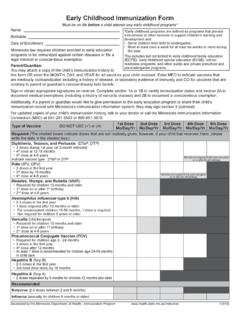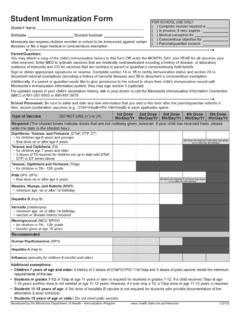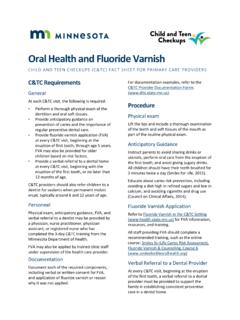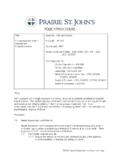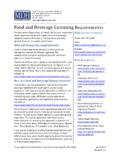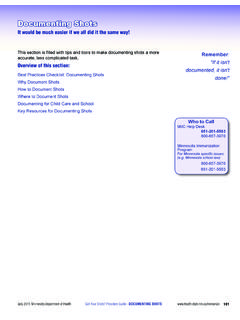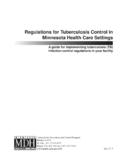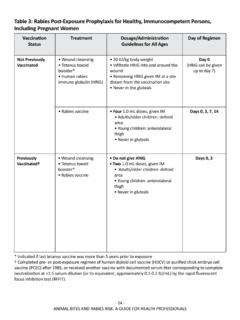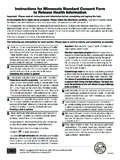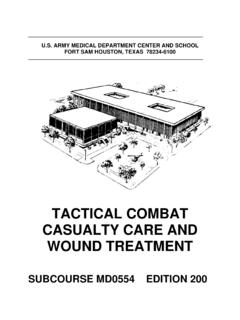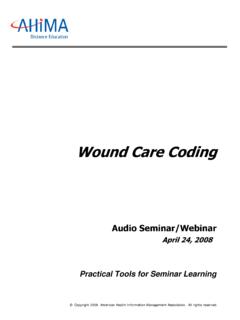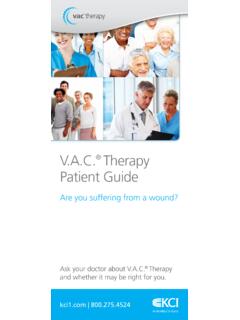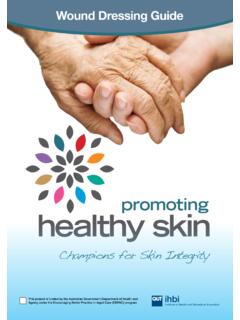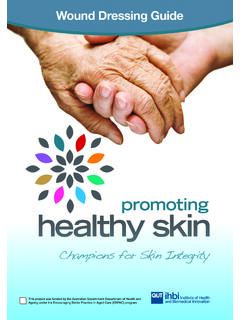Transcription of Wound Care Infection Prevention Recommendations for …
1 1 Wound care Infection Prevention Recommendations for Long-Term care Facilities Wound care treatments and services provided in the long-term care setting can entail complex procedures utilizing a wide array of products and/or equipment. The following Wound care Infection Prevention and control Recommendations are designed to assist long-term care facilities with general principles and are not all-inclusive. For further assistance regarding Wound care Infection Prevention and control questions please email o r call the minnesota department of health at 651-201-5414. Administrative controls Facility has current, evidence-based policies and procedures readily available regarding Wound detection, assessment, and management, which are reviewed and updated on an annual basis.
2 Resources about Wound care are available for staff to utilize should questions or concerns arise ( , nursing reference book with checklists). The facility has a competency-based program for training all personnel who provide Wound care upon hire and annually thereafter. Education is provided when new equipment or protocols are introduced. The facility audits (monitors and documents) adherence to Wound care policies and procedures and provides feedback to health care workers (HCWs), including contracted staff, regarding their performance of Wound care . Audits should be conducted with a standardized tool on a routine basis. HCWs will receive education focused on gaps identified during audits. The facility keeps a record of all types of Wound and skin infections identified in residents receiving Wound care .
3 When necessary, transmission-based precautions or Enhanced Barrier Precautions (EBP) are implemented based on CDC guidance. CDC: Guideline for Isolation Precautions: Preventing Transmission of Infectious Agents in Healthcare Settings ( ) CDC: Implementation of Personal Protective Equipment (PPE) in Nursing homes to Prevent the Spread of Multidrug- Resistant Organisms (MDROs) ( ) The facility displays hand hygiene posters in heavily trafficked areas. CDC: Healthcare Providers | Hand Hygiene ( ) Hand hygiene Perform hand hygiene prior to starting Wound care for each resident: This includes before retrieving Wound care supplies, before donning gloves, and after doffing gloves. Wound care Infection Prevention Recommendations FOR LTC FACILITIES 2 Alcohol-based hand rub (ABHR) should be readily accessible throughout the Wound care process.
4 Unless hands are visibly soiled, alcohol-based hand rub is preferred over soap and water. Ways to ensure this include keeping ABHR close to the bed (point of care ) in the room when performing Wound care . CDC recommends placing FDA-approved alcohol-based hand sanitizer with 60-95% alcohol in every resident room (ideally inside and outside of the room) and in other common resident care areas. HCWs should not touch items in the resident care environment while performing Wound care as this will contaminate gloves, supplies, and/or the environment. Hand hygiene must be performed by use of ABHR or soap and water immediately after removing gloves and upon exiting resident room. Personal protective equipment (PPE) Keep PPE available in all sizes for staff and providers. Wear gloves during all stages of Wound care including when applying new dressings.
5 Don gloves after preforming hand hygiene. During an individual resident s Wound care , doff gloves every time when going from dirty to clean surfaces or supplies. Perform hand hygiene after doffing gloves and before reapplying clean gloves. Wear a mask and eye protection if there is any chance of splashes or sprays ( , wounds with drainage, especially during debridement and irrigation). Wear a clean gown to cover arms and clothing that may come in contact with the resident or the resident s care environment for each dressing change. Doffing PPE in correct order to decrease spread of Infection and cross contamination. Place used PPE in appropriate receptacle (waste or covered soiled laundry). health care workers should wear a gown and gloves for all Wound care per CDC s EBP guidance: Implementation of Personal Protective Equipment (PPE) Use in Nursing Homes to Prevent Spread of Multidrug-resistant Organisms (MDROs) ( ).
6 Wound care equipment and supplies Any reusable equipment ( , bandage scissor, flashlight, mirror) and supplies that come in contact with non-intact skin, mucous membranes, or any bodily fluids or drainage, including fluids on bedding or gloved health care workers hands, are considered semi-critical instruments. Either: 1. Perform high-level disinfection (HLD) before use on another resident OR 2. Discard Wound care equipment or products when no longer needed for an individual resident. When HLD (or sterilization) is not available and dedicated equipment is used for each resident, it is important to clean and disinfect each piece of equipment after each use on the same resident to reduce bio load per manufacturer s instructions for use (IFU). Wound care Infection Prevention Recommendations FOR LTC FACILITIES 3 Dispose of dedicated equipment (if disposable equipment is used) or arrange to have dedicated equipment appropriately processed after no longer needed for care of the designated resident.
7 CDC: Guideline for Disinfection and Sterilization in Healthcare Facilities ( ) Dedicate tape, sprays, creams, and all Wound care products to an individual resident and do not store used sprays with clean Wound care supplies. If fresh bandages are cut for the resident, it should be done with clean scissors, not with scissors used to cut off soiled bandages. Wound care dressings can be disposed of in the regular trash unless they are dripping or saturated with blood or other regulated body fluids. minnesota Pollution Control Agency: Infectious Waste Management Guidance for Transporters ( ) Clean and disinfect the surface ( , over bed table) where Wound care supplies will be placed prior to setting down Wound care supplies in resident room. Store Wound care supplies in a clean area of resident room.
8 minnesota department of health Infection Control Assessment and Response (ICAR) Program PO Box 64975 St. Paul, MN 55164-0975 651-201-5414 11/30/2022 To obtain this information in a different format, call: 651-201-5414.

